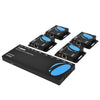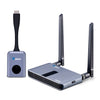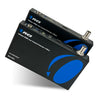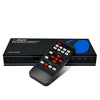
Connecting your audio devices to TVs or soundbars may be a confusing process for some, especially if you’re not familiar with the different types of available audio connections. Two of those, which are Optical Audio and HDMI ARC, are some of the most popular options with each having its own unique benefits. If you’re having a hard time choosing which one to use for your audio setup, or you simply want to understand both of them better, then this is for you.
What is Optical Audio?
Optical Audio, also known as Toslink, is a type of audio connection that uses fiber optic cables to transmit digital audio signals. It is known for its reliability and its resistance to interference, making it a popular choice for those wanting the best possible audio experience.
One benefit of using Optical Audio is that it’s capable of transmitting audio signals without any loss in quality, making it an excellent choice for audiophiles. Optical Audio is also capable of carrying Dolby Digital and DTS audio signals, which is why it is also a popular choice for people setting up a home theater system.
What is HDMI ARC?
HDMI ARC, or Audio Return Channel, is an HDMI feature that mainly allows audio signals to be sent from your TV back to your audio device, such as a soundbar or other sound systems, using a single HDMI cable. HDMI ARC makes it easier for people to set up their audio system by eliminating the need for additional cables.
What makes HDMI ARC special is its capability of transmitting high-quality audio signals, including multi-channel audio formats like Dolby Atmos and DTS:X, something that Optical Audio cannot do. It is also able to transmit video signals, making it a versatile choice for anyone creating an entertainment setup.
Optical Audio vs. HDMI ARC
Since both technologies are capable of transmitting high-quality audio signals, they still have some key differences. Here are a few:
-
Cable Type
As mentioned earlier, Optical Audio uses fiber optic cables while HDMI cables use either a combination of fiber cables and copper wires, or purely copper wires. Optical Audio's exclusive use of fiber optic cables renders them less vulnerable to interference from high-powered appliances. Conversely, HDMI ARC has the benefit of being able to transmit video signals in addition to audio.
-
Audio Quality
Since Optical Audio’s technology makes them less prone to interference, they are mainly chosen to get the best possible audio experience. But if interference is not a problem for you, then choosing HDMI ARC won’t be an issue.
-
Compatibility
HDMI ARC was originally introduced in 2009, while Optical Audio came into circulation around the 1980s. This fact alone makes Optical Audio compatible with more devices. However, when building a setup with newer models, you may find that the more recent sound systems can provide you with both options.
Which one should you choose?
Choosing between Optical Audio or HDMI ARC ultimately depends on your specific audio setup and needs. Here are some things that may help you in choosing which one you should go for:
If you’re planning on building a home theater system where you can get the best possible audio experience, you may want to consider going for Optical Audio. It is also the better option if you have an older TV that doesn’t readily support HDMI ARC.
For people who want a simpler, cleaner setup – a setup where you don’t have to worry about having to run multiple cables – then HDMI ARC is for you. If you also want to enjoy the excellent sound quality of Dolby Atmos and DTS:X, you should go for HDMI ARC.
Now if you own a soundbar and you’re wondering which technology you should use, you may find the following interesting.
Since we have already established that both Optical Audio and HDMI ARC are great, here are a few more things you may want to consider:
When it comes to soundbars, both Optical Audio and HDMI ARC have distinct advantages that can make them superior depending on your specific requirements.
For example, if you want to use your soundbar with an older TV that lacks an HDMI ARC port, you must use Optical Audio. Additionally, if you're concerned about interference from other electronics in your home, Optical Audio may be a better option than HDMI ARC.
However, if you have a newer TV with an HDMI ARC port, using HDMI ARC may be a more convenient option because you won't have to use a separate cable for Optical audio. Also, HDMI ARC supports higher-quality audio formats such as Dolby Atmos, which is becoming increasingly popular in modern soundbars.
Another advantage of HDMI ARC is CEC, which allows you to use your TV remote to control the volume of your soundbar. Which is a useful feature if you don't want to juggle multiple remotes.
Lastly, before we end this discussion, let’s talk about workarounds.
Let’s say that you’re already set on using either Optical Audio or HDMI ARC, but your TV or your speaker does not support it. In this case, you may opt to use an audio converter.
For example, for TV units that only have an HDMI port, but you want to use your speaker with Optical Audio technology, using an audio converter can easily resolve this issue. This solution also works vice versa.
Now, if you want to use your HDMI ARC sound system for your TV but only have a single HDMI port, you don’t have to sacrifice it so that you could connect other types of HDMI devices. Likewise, you don’t have to constantly plug and unplug your HDMI cables every time you have to use one or the other. For issues like this, you may want to consider using an HDMI switch with an ARC audio extractor. With an HDMI switch that supports ARC, you can easily connect more devices to your TV and at the same time, maintain the organized look of your setup.
You can purchase your HDMI ARC audio extractor in our shop, as well as audio converters. We included a guide on how you can use it for your setup so you’re sure that you can utilize it properly.
In the end, both HDMI ARC and Optical Audio are great choices for connecting your audio devices to your TV or soundbar. Choosing between the two all boils down to your specific needs and preferences. Especially now that other types of technologies can allow you to use either of the two for any type of home theater setup you want to accomplish.
Do you want to learn more about what you can do with HDMI devices? Check out more easy reads like this in our blog!





















Comments
My tv remote controls through ARC or Optical. With optical it doesn’t match the tv volume number unless I do one click at a time whereas I can get an accurate sound number no matter how long I hold the button with ARC. My ARC is also one of 2 ports that supports full 4k 120hz so I need it for gaming consoles. Something to consider is what else needs that HDMI port.
I have a newer Sony with eArc on the back. I just purchased a Sonos Arc Ultra. 3 times the power went out and I lost connection to the soundbar. Sonos said it’s not them. Called Sony. I have to give them access to my tv to correct something internally. This last call to Sony told me to get a Lindy HDMI CEC from Amazon. I ordered to today. We will see if it corrects the issue. So for now I went to the Optical option.
From a User Experience perspective, the main thing I look for in TV / Amp connectivity is: I want to be able to use the TV Remote volume to control the Amp. I do not want to have to use a separate volume control to do this. As far as I know, this can be done with HDMI ARC, but not with Optical – is that correct?
Hi, I have a new LG smart TV and have connected my LG soundbar via HDMI ARC. Why is the volume softer on normal TV and loud on streaming etc 10+ and Paramount etc. I’ve tried everything. Please help🙏
I just connected my 20 year old Samsung 42” (with crackling speakers) to a new Denon DHT-S316 soundbar and subwoofer. I was intent on using optical until I found that the jack on the TV was an older style and I would have to buy an adapter. Meanwhile I was pleasantly surprised to find that the Samsung has an HDMI ARC port. So I connected that and with a bit of research and fiddling with settings on the TV I finally got sound.
The biggest bonus with ARC is having volume control on the Samsung remote. Also, when I turn off the TV, the soundbar also turns off. I’m not sure I would notice any difference in quality, my hearing is too far gone for that, but I’ll grab an adapter and give it a go.
Other than that the soundbar and subwoofer is anwesome and has a great theatrical depth of sound to it.
Thanks alot for the information 🙂..have now bought my HDMI and going to the house at 9pm smiling 😁
I bought a Roku Streambar for my Insignia flatscreen dumb TV because the volume on the tv was very low. Now I notice the volume on the TV gradually goes in and out and so does the volume on the Roku streambar. I had my tv originally hooked up to an external tower speaker and I liked it because it gave a really nice full sound. Now that I am using the Roku Streambar I am not able to utilize the external speaker anymore because when I plug the input into the arc it out rules any sound going from the TV to the speaker. Since the TVs speakers are off while using a streambar, which one: optical or Arc would allow the the sound to go to an external speaker as well as the streambar?